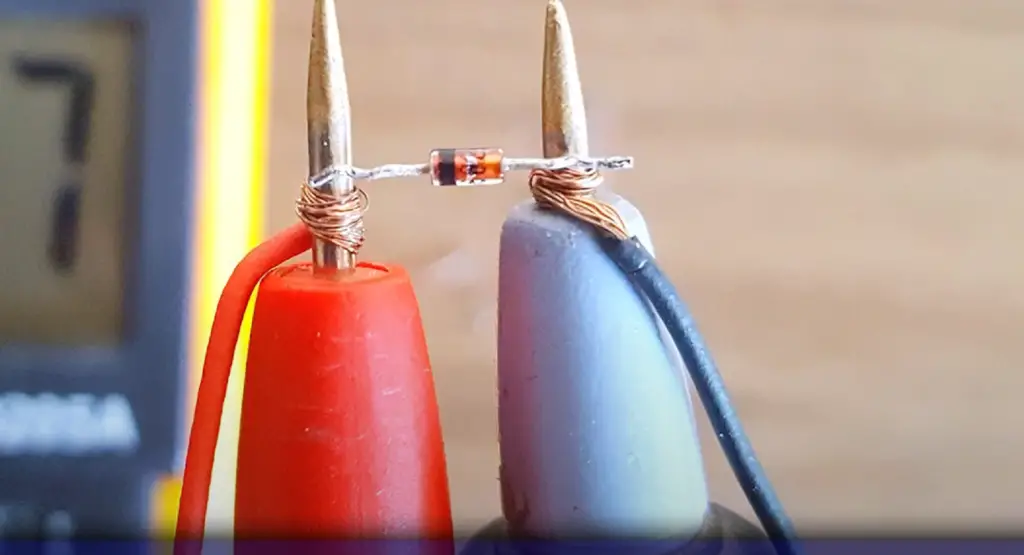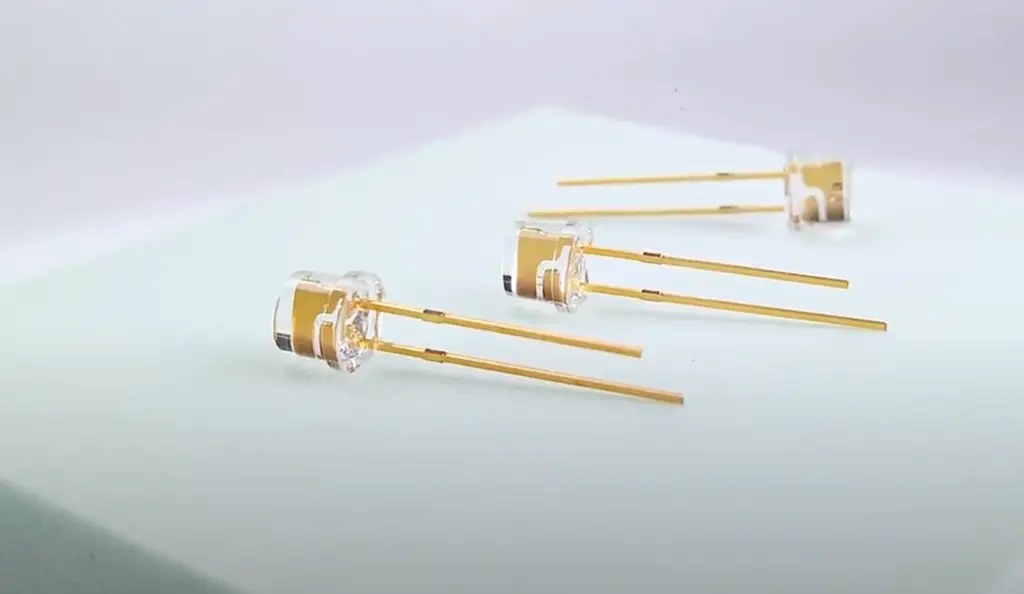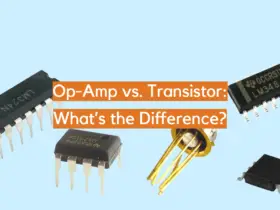Are you needing to understand the 1N4002 diode pinout and specifications? Whether you’re a beginner or an experienced electrical engineer, understanding how your circuits connect is essential for avoiding damages and correctly constructing your designs. In this blog post, we will go through what you need to know about the pinout of the 1N4002 diode as well as its power ratings so that you can make sure your circuit design works properly!
1N4002 Diode Explained
The 1N4002 diode is an example of a standard type of semiconductor device called a rectifier. It has two pins—an anode and cathode—and helps regulate the flow of electricity in circuits, allowing current to pass in one direction while blocking it from flowing in the opposite direction.
This diode is also referred to as a general-purpose rectifier, meaning that it can be used for many types of electronic projects and applications. In addition, its lead spacing makes it well-suited for through-hole mounting. The 1N4002 has a wide variety of uses, including DC power supplies, AC adapters, and general-purpose electronic equipment. [1]

1N4002 Pinout and Specifications
The 1N4002 diode is a versatile, cost-effective tool with an extremely rapid reverse recovery time and low forward voltage drop. The 1N4002 has two pins, an anode (positive) and a cathode (negative). From rectification to protection circuits and signal detection, the applications of this technology are vast.
The pinout of the 1N4002 is shown below:
- Pin 1 – Anode (+)
- Pin 2 – Cathode (-)
The specifications of the 1N4002 are as follows:
- Maximum Repetitive Peak Reverse Voltage: 30V
- Average Rectified Forward Current:1A
- Reverse Recovery Time: 4µs
- Forward Voltage Drop: 0.8V
- Storage Temperature: -65°C to +150°C
- Lead Soldering Temperature: 260°C (5 sec max)
- Operating Temperature Range: -55°C to +175°C.
1N4002 Features
- Low Forward voltage drop
- Fast switching capabilities
- High-temperature soldering guaranteed: 260°C/5 sec at terminals. [2]
The 1N4002 diode is an excellent choice for many applications as it offers reliable performance and a wide operating temperature range. It can be used in rectification, protection circuits, signal detection and more, making it a versatile and cost effective option. With its low forward voltage drop and fast switching capabilities, the 1N4002 will help you get the job done quickly and efficiently. So if you’re looking for a high quality general purpose diode with great features, then the 1N4002 should be your go-to choice!

1N4002 Replacement and Equivalent
The 1N4002 diode can be replaced with equivalent diodes like the IN4002, 1N4003, 1N4004 and other similar devices. The specifications of these components are mostly the same, however it is important to check the full specification sheet before making any replacements. Some common applications for these diodes include power supply rectification, voltage clamping, reverse polarity protection and flyback diode protection. These components are widely available and easy to source from electronics suppliers.
In addition to its use as a replacement device, the 1N4002 diode can also be used as an equivalent part in certain situations. For example it can be used as an alternative for Zener Diodes when the breakdown voltage is not critical. It can also be used in place of Schottky diodes when a lower forward voltage drop is required.
Overall, the 1N4002 diode is an inexpensive and reliable way to provide protection against reverse polarity, overvoltage and short circuits in many applications. Its wide availability and simple pinout make it easy to find and use as a replacement or equivalent part for other components.
Where to Use 1N4002 Diode
It is often used as an input protection device in power supplies, allowing the current to flow safely and preventing it from flowing backward into the circuit. The 1N4002 can also be used as an output protection device, regulating the current coming out of a power supply or circuit and preventing spikes.
In addition, it is commonly used as a voltage regulator in circuits such as audio amplifiers or radio receivers. Its wide range of applications makes the 1N4002 diode invaluable for many electrical projects. The pinout of this diode allows for easy connection and installation within any project layout. With its small size and low voltage drop, the 1N4002 is a great choice for many applications.
Lastly, the diode can be used in rectifier circuits to convert AC into DC power. As a bridge rectifier, it directs the current flow and provides a clean, steady output of DC electricity. The 1N4002 diode can also be useful for blocking reverse currents in electronic parts such as relays and transistors. With its versatile functionality and high-performance capabilities, it is an excellent choice for many projects requiring reliable protection from unwanted electrical spikes or surges. [3]
How to Safely Long Run in a Circuit
Using the 1N4002 diode in a circuit requires taking proper precautions to ensure it runs safely and for a long period of time.
To begin, make sure all power sources are correctly rated for the desired voltage level. When connecting the 1N4002 diode to any other components, ensure that its polarity is correct; otherwise, it may be damaged by reversing current. If possible, try to use an additional protection element such as a fuse or resistor in series with the diode, as this will help limit the maximum amount of current flowing through it.
Additionally, take into account the ambient temperature around where the 1N4002 will be located; if it is too high or low, then its performance may suffer due to temperature dependent variations in its operating characteristics. Lastly, make sure to keep the diode clean and free of any dust or debris that can accumulate over time and impede its performance.
By following these precautions, you can ensure that your 1N4002 diode will have a safe and long running lifetime in your circuit.

1N4002 Applications and Uses
The 1N4002 diode is a widely used rectifier diode, which means it can convert AC power to DC power. This makes the 1N4002 popular for a variety of applications related to rectification, or turning alternating current (AC) into direct current (DC).
Common applications include use in power supplies, motor speed control, voltage regulator circuits, and more. Not only is this diode highly versatile but it’s also very reliable with its high surge capability that allows it to stand up to transient voltages from motors and other sources where there are sudden surges. This makes the 1N4002 an ideal choice for use in industrial and commercial applications.
In addition to its primary functions of rectification, the 1N4002 can also be used in a full-wave bridge rectifier circuit. This type of circuit is often found in power supplies and AC adapters for DC equipment like laptops and cell phones.
The diode’s low forward voltage drop and high current ratings make it an ideal choice for automotive applications as well. It’s commonly used in car audio systems, headlights, and other automotive electronics that require direct current to operate efficiently.
Due to its affordability, durability, and ease of installation, the 1N4002 diode is one of the most popular diodes on the market today. The versatile design makes it suitable for many different types of electronic applications and with its simple pinout configuration, the 1N4002 is a great choice for those looking for a reliable and cost-effective electronic solution. [4]
Benefits and Cons of Using 1N4002 Diode
The 1N4002 Diode has many useful benefits when used in a variety of applications. It is an inexpensive, reliable component that can handle high current and voltage ratings. As a result, the 1N4002 Diode works well for rectification and power supply needs. Additionally, its low forward voltage drop makes it ideal for protecting sensitive components from electrical surges or providing reverse polarity protection. Furthermore, it is easily available in most electronic stores.
However, the 1N4002 Diode also has some drawbacks that should be taken into consideration before using it in any application. For example, due to its low switching speed, it may not be suitable for high frequency applications such as radio transmission. Moreover, since it is made from silicon, it can experience thermal runaway in applications where high reverse current flows. Finally, its maximum repetitive peak reverse voltage (PRV) of 200 volts limits the total voltage it can handle.

Overall, the 1N4002 Diode is a useful and reliable component that provides many benefits for various applications. However, its limitations should be taken into account before making a decision to use it in any application. [5]
FAQ
What is the voltage of the 1N4002 diode?
The 1N4002 diode has a maximum voltage of 30V. It is designed to block reverse current flow and can handle up to 1A of reverse-current leakage under normal conditions.
What is the current rating of the 1N4002 diode?
This rating should not be exceeded, as doing so may result in permanent damage to the diode. When used in an AC circuit, the 1N4002 diode can handle a maximum current of 2A peak. The 1N4002 diode is rated for repetitive peak reverse voltage (VRRM) up to 400V and non-repetitive peak surge current of 35A. It has a forward voltage drop (VF) of approximately 0.9V at 1A and a capacitance of about 0.4pF between pins. The 1N4002 diode is widely used due to its low cost, high reliability and wide temperature range (-55°C – +125°C). It is often used in power supplies, automotive circuits, and general-purpose diode applications.
What is the 1N4002 diode used for?
The 1N4002 diode is a popular general-purpose silicon rectifier diode commonly used for power supply applications. It can be used to convert AC into DC, provide voltage regulation and protection against reverse polarity and overvoltage. The diode also has low leakage current features, making it suitable for high frequency switching applications. Additionally, the 1N4002 diode can also be used in earphone circuits to protect the speakers from high voltage transients. Its wide range of uses makes it an essential component in many projects. When using this particular diode, it is important to note its pinout information as some models may have different configurations than others.
What is the difference between 1N4007 and 1N4002?
The 1N4007 and 1N4002 have similar characteristics, however there are some important differences to note. Firstly, the 1N4007 has a higher peak repetitive reverse voltage than the 1N4002 (1000V vs 400V respectively). In addition, the 1N4007 can handle higher current ratings compared to the 1N4002 at a maximum of 8A instead of 2A. Lastly, the junction capacitance of the 1N4007 is about twice that of the 1N4002. In summary, if you require better protection against high voltages or currents or need lower junction capacitance then it may be worth considering using a different diode such as the 1n4007. Overall, the 1N4002 is still the most popular and widely used diode for general purpose applications. It is also important to note that all diodes have a forward voltage drop which depends on the current being passed through it. For the 1n4002 this value is typically around 0.6V – 0.7V so it’s best to take this into consideration when planning your circuit design.
Useful Video: How to Test the Voltage of Zener Diode without variable DC power supply
Conclusion
The 1N4002 diode is an incredibly versatile component that can be used for a variety of electrical engineering applications. Its low forward voltage drop and high peak reverse voltage make it ideal for protecting sensitive electronic components from excessive current or surges. Additionally, its relatively small size makes it easy to incorporate into designs with minimal space constraints. With its wide range of capabilities, the 1N4002 diode is sure to remain a reliable and useful part in many projects long into the future.
References
- https://www.utmel.com/components/1n4002-diode-pinout-datasheet-and-equivalents?id=318
- https://components101.com/diodes/1n4002-diode-pinout-details-datasheet
- https://www.componentsinfo.com/1n4002-diode-pinout-equivalent-datasheet/
- http://www.el-component.com/diodes/1n4002
- https://www.apogeeweb.net/circuitry/1n4002-diode-introduction.html














Leave a Reply